
What the Return of the “Tariff Man” Means for the Canadian and U.S. Economies
Stephen Tapp, Chief Economist, Canadian Chamber of Commerce
Trevor Tombe, Professor, Department of Economics and the School of Public Policy, University of Calgary
Early this week, Donald Trump proved his social media posts can still shock the world when he announced plans to impose a 25% tariff on all U.S. imports from Canada and Mexico.
We’ve seen similar tactics before. In his first term, Trump boldly proclaimed that “Trade wars are good and easy to win.” In fact, we learned that trade wars are bad and everyone loses. They create chaos and bring massive direct economic costs, while imposing widespread collateral damage.
In preparing for the possibility of a second Trump term, a recent BDL report, Partners in Prosperity, written by Trevor Tombe, examined the significance of the Canada-U.S. economic relationship. It revealed what most Canadians intuitively understand — access to the U.S. market is critical for Canada’s economy.
The flip side of this — Canada’s economic importance to the U.S. — is underappreciated south of the border. Many Americans and their elected officials don’t know that Canada is the top export market for the U.S. nationally and for 34 individual states. This relationship matters not only along the northern U.S. border, in places like Michigan and Montana, but across the entire U.S. economy, reaching all the way down to the Southern border in Mississippi and Florida.
CANADA IS A KEY EXPORT MARKET THROUGHOUT THE U.S.
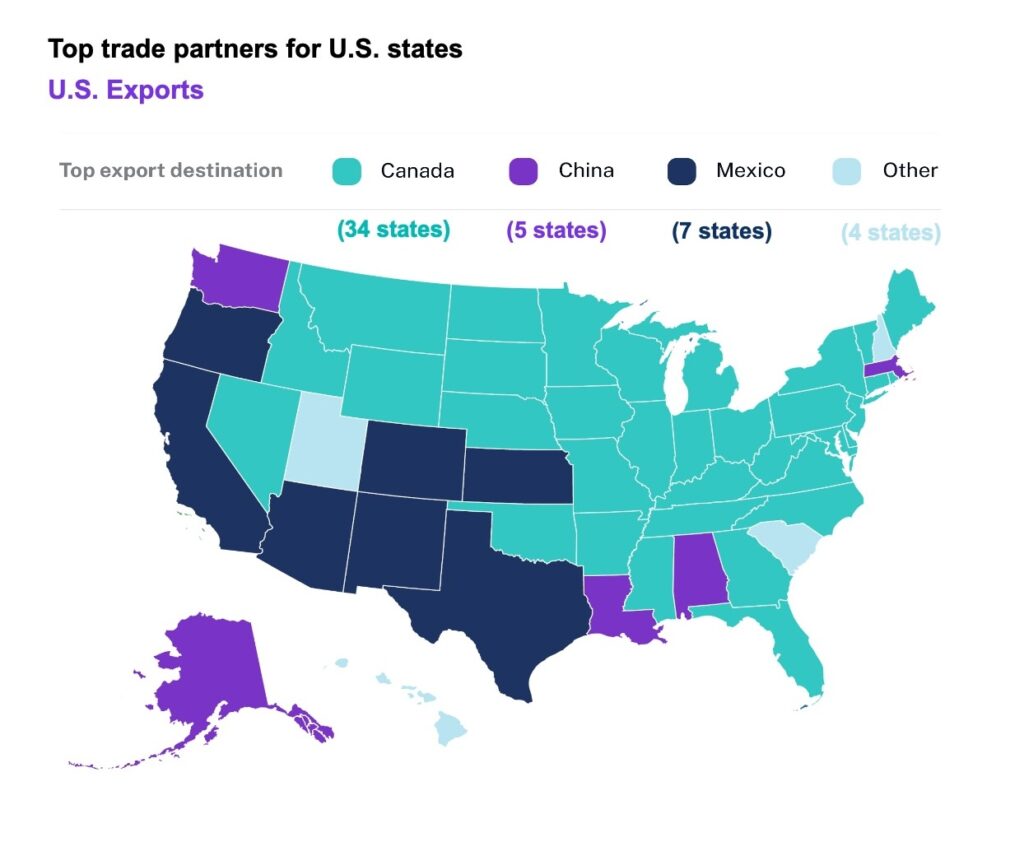
Source: BDL’s Partners in Prosperity report.
Our two economies are deeply integrated in agriculture (the food we eat), manufacturing (the cars we drive), the financial system (funding household spending and business investments), energy markets (powering our economy) and more.
WE MAKE THINGS TOGETHER
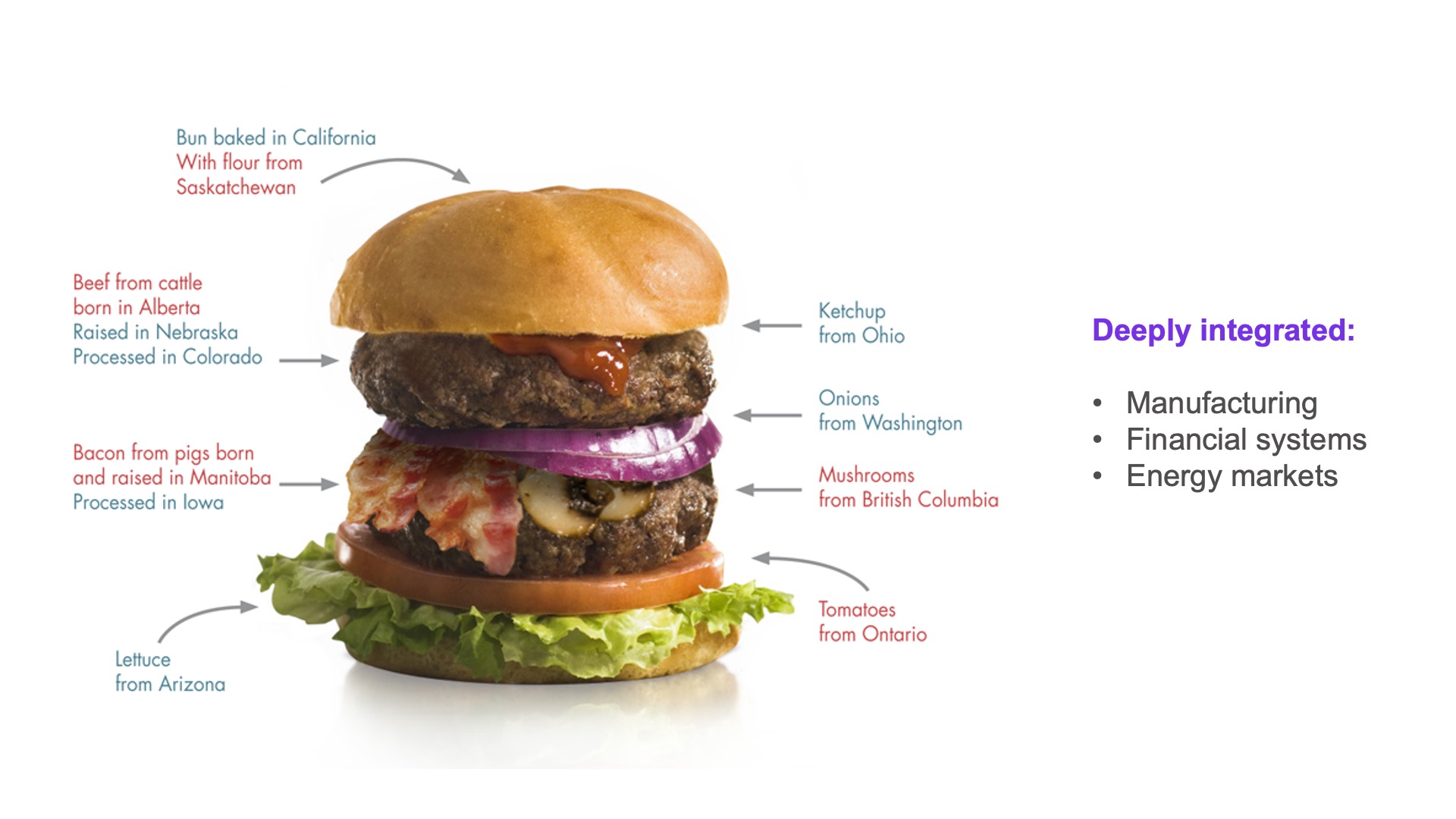
Source: Agriculture and Agri-food Canada.
In this time of growing protectionism, Canada is a critical and reliable supply chain partner for U.S. companies and consumers. Conventional trade discussions typically imagine finished goods crossing the border. But this report shows that over three-quarters of our bilateral trade with the U.S. is business inputs, such as manufacturing parts, energy and capital goods. In fact, given cross-border operations, a significant share of Canadian exports to the U.S. are actually inputs for U.S. companies that originally came from other U.S. companies. These complex linkages mean:
- Canadian exports to the U.S. indirectly boost incomes, create jobs and raise wages for other U.S. businesses and workers, beyond the immediate transactions.
- Maintaining efficient cross-border supply chains makes both countries more competitive, benefitting workers and businesses and increasing economic resilience to global shocks.
- Trump’s tariffs will disrupt these long-established trade patterns, raising costs for businesses, and raising prices for consumers that just suffered through a pandemic and the highest inflation in generations.
Canada and the U.S. make things together in impressive commercial relationships that have grown over decades. It simply makes more sense to work together than to go it alone.
TRUMP’S NEW TARIFFS WOULD HURT CANADA AND THE U.S.
In the original report, Professor Tombe modelled the impacts of a 10% across-the-board U.S. tariff on imports. Trump’s latest announcement upped the ante to 25%. After updating these estimates, we show the extent to which this really is a “nuclear” threat from Trump.
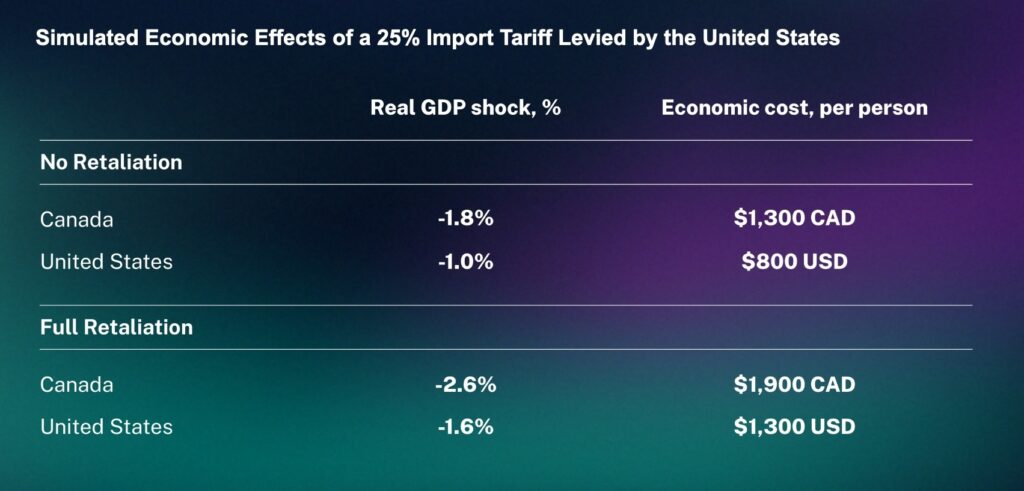
Source: Update of the BDL’s Partners in Prosperity report.
Note: BDL calculations using a general equilibrium model of the global economy.
In a scenario where impacted countries retaliate with tariffs of their own against U.S. exports (as occurred for steel and aluminum tariffs in Trump’s first term), we would expect significant economic losses on both sides of the border, rising to roughly $1,900 CAD per Canadian, and $1,300 USD per American.
The most heavily impacted sectors would be energy, autos, mining, pharmaceuticals, chemical and forestry products. If no exemptions were granted, this policy could push Canada’s economy into recession by the middle of 2025 — but make no mistake, it would also represent a significant disruption to the U.S. economy.
BIGGEST HITS TO ENERGY, AUTO, METALS TRADE
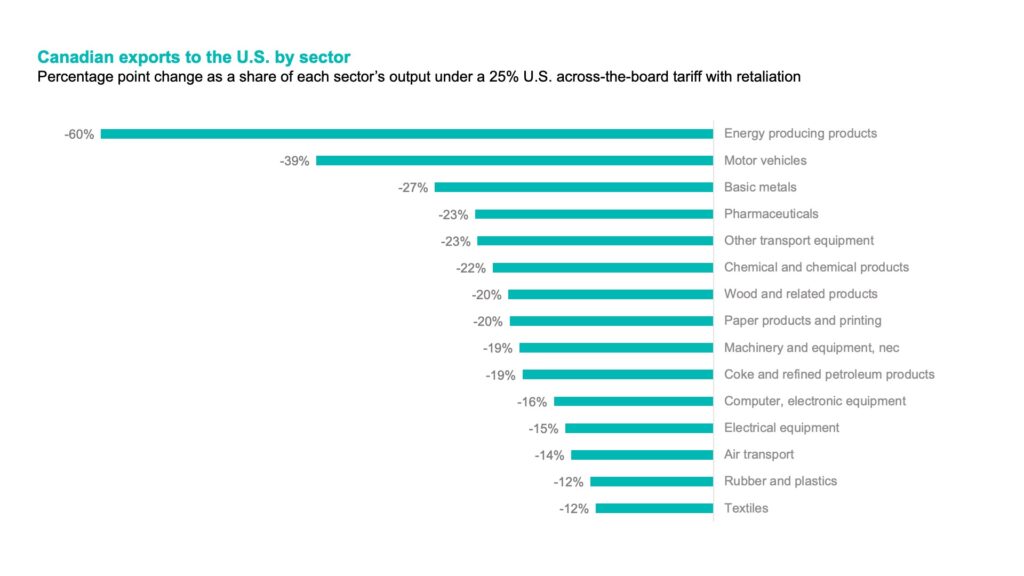
Source: Update of the BDL’s Partners in Prosperity report.
Note: BDL calculations using a general equilibrium model of the global economy.
WHAT WILL BE SOME KEY ECONOMIC REACTIONS IN THE NEAR TERM?
Financial markets are the fastest to integrate new information. In the near term, we expect exchange rate reactions, featuring a stronger US dollar (which is viewed as a “safe haven asset” in times of uncertainty), and similarly a weaker Canadian dollar (which other things equal, makes Canadian products cheaper and encourages our exports).
Perhaps counterintuitively, over the next few months, we expect a surge in U.S. imports from Canada and Mexico, as Americans build up inventories and make their purchases ahead of any potential tariffs. We saw this same behaviour last time with a roughly 20% increase in Canadian exports of steel and aluminum products to the U.S before tariffs came in. Over the 13 months those tariffs were in place, trade fell by a cumulative 16% overall — and more than 40% by the end relative to pre-tariff levels — representing a loss of roughly $2.4 billion in Canadian exports in these two products alone.
TRUMP’S PAST TARIFFS TOOK A TOLL ON CANADA
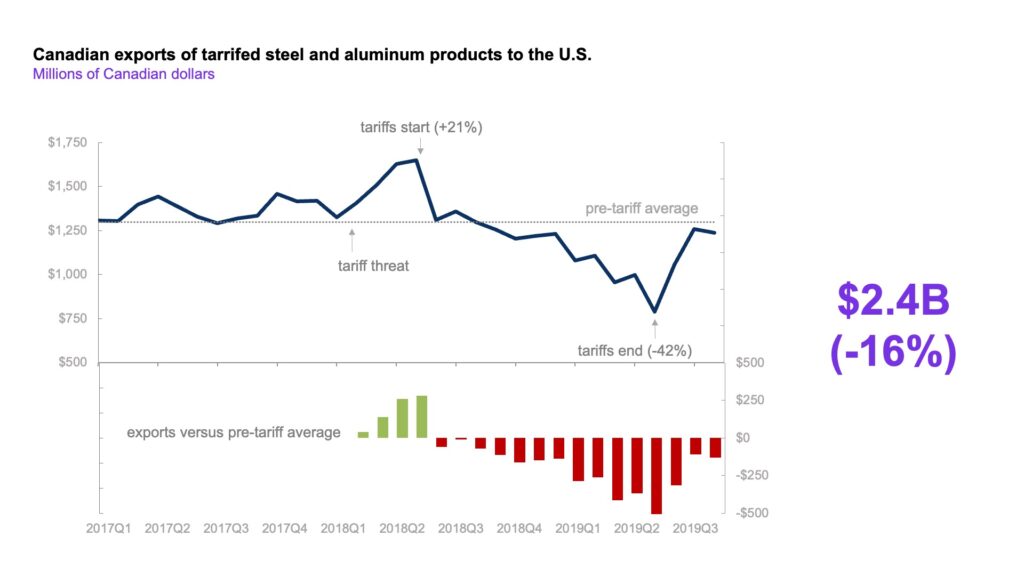
Source: Calculations using Statistics Canada trade data.
Another key impact will be a dramatic increase in U.S. trade policy uncertainty, as we witnessed in Trump’s first term, when he imposed sweeping tariffs on China, threatened massive auto tariffs and even threatened to walk away from NAFTA . The only other time of significant trade policy uncertainty was in the early 1990s around the original negotiations that expanded the Canada-U.S. free trade agreement to include Mexico as part of NAFTA.
WEAPONIZING U.S. TRADE POLICY UNCERTAINTY

Source: Baker, Bloom and Davis via Haver
The result of this elevated uncertainty will likely be investment hesitation in Canada, as businesses wait on the sidelines, seeking more clarity on the rules of trade, before making big bets on large projects.
Trump’s opening tariff gambit is clearly designed to destabilize other countries and bring them to the negotiating table to extract concessions. This is the Art of the Deal part two — as is often the case, we worry that the sequel will be worse than the original.
For their part, other countries are now reviewing detailed American import categories, especially those from key ridings where retaliatory tariffs would inflict the most salient impact.
We learned from Trump’s first term that Canada should take this threat seriously, if not literally. We need not panic. We have some of the world’s best trade negotiators and some time to calmly and rationally assess our options. A few areas that are obvious irritants to the U.S. where they will likely seek concessions include:
- Canada’s impending digital services tax, which is seen as retroactively targeting large U.S. tech giants.
- Canada’s inability so far to present a credible plan to hit NATO’s 2% of GDP defense spending target.
- Reforming Canada’s outdated supply management system for milk and poultry.
At the end of the day, Canada-U.S. economic collaboration benefits both countries, and our research brings a stark warning about the serious economic consequences for both sides from enacting protectionist policies. Only by pursuing an end game of looking for win-wins can we ultimately ensure our shared economic security and prosperity. Thankfully there are some to be found. The alternative of trade wars would leave our businesses less productive and less globally competitive, our consumers paying higher prices, and the rules-based global trading system in chaos. While the “Tariff-man” didn’t seem to care about these things the last time around, let’s hope cooler heads prevail.















